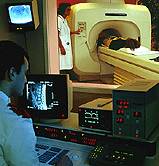
TUESDAY, April 27 (HealthDay News) — Among cancer patients on Medicare, the costs for medical scans have increased twice as fast as overall costs for cancer care, Duke University researchers report.
“There has been a significant increase in the utilization of imaging services for cancer patients since 1999, especially advanced imaging services such as CAT scans, MRI and PET scans — the most expensive studies,” said lead researcher Dr. Kevin A. Schulman, a professor of medicine and business administration and associate director of the Duke Clinical Research Institute.
Schulman noted that more scans do not necessarily result in better treatment or outcomes. Patients, he added, can play a role in limiting the number of unnecessary scans.
“It’s OK to ask your physicians why they are ordering an imaging test and how you might benefit from the result,” he said.
The Duke report is published in the April 28 issue of the Journal of the American Medical Association.
For the study, Schulman’s group collected data on imaging costs of 100,954 cancer patients on Medicare who were diagnosed with breast, lung, prostate or colon cancer, leukemia or lymphoma between 1999 and 2006.
The researchers found that while overall costs for treating these patients rose 2 percent to 5 percent a year, the cost for imaging scans increased between 5 percent and 10 percent.
Although the costs for imaging increased faster than costs for overall care, imaging costs make up only about 6 percent of Medicare costs for each patient, the researchers noted.
The most growth was seen in the number of PET scans. The average annual number of PET scans grew from 36 percent to 53 percent, but they still remain the least-used scanning technology. However, these scans are the most expensive, running as much as six times higher than CT scans.
When PET scans were first introduced, Medicare did not pay for them, but by 2005 about 50 percent of patients with lung cancer and lymphoma were getting one or more PET scans, Schulman noted.
In 1999, patients diagnosed with lung cancer had about 21 imaging scans during the first two years of treatment. By 2006, that had increased to 24.
The highest imaging costs were for patients with lung cancer and lymphoma, averaging $3,000 during the first two years of treatment, the researchers found.
In addition, bone density studies increased in popularity. In fact, the number of breast cancer patients getting bone density studies almost doubled by 2005, with about one-third of all patients receiving one or more scans.
Michael T. French, a professor of economics, epidemiology and public health at the University of Miami, isn’t surprised that these costs have gone up so dramatically.
“Imaging has advanced considerably in recent years,” he said. “So, it’s logical that it would be used more often, and along with the higher costs of increased use are the costs of improved technology.”
French thinks that some of the increased use of imaging is related to increased reimbursement and competitiveness among hospitals. “Is there excessive use of imaging to improve profits? Yes,” French said.
In addition, there is a defensive aspect to the increased use of imaging, French said. “If the technology is present and physicians don’t use it, then if something happens to the patient there is a possibility for a lawsuit,” he said.
The bottom-line question is how imaging is being used, French said. “It’s a question of whether it’s wasteful or whether it’s higher cost to produce better outcomes,” French said. “Right now, we don’t know what all this leads to in terms of better outcomes.”
A group representing the medical imaging industry believe they have an answer to that question, however.
The Access to Medical Imaging Coalition point to a recent study, conducted by Columbia University professor of business Frank Lichtenberg and based on data from the National Cancer Institute and Thomson Medstat. That study found that, “cancer imaging innovation accounted for 40 percent of the reduction in U.S. cancer deaths between 1996 and 2006, making it likely the largest single contributor to decreased cancer mortality during this time period,” according to a news release from the coalition.
“Given that previous researchers have equated a one percent reduction in cancer mortality to nearly $500 billion in health care savings per year,” the findings suggests a role for medical imaging in cutting health care costs, the group said.
More information
For more information on cancer, visit the American Cancer Society.

